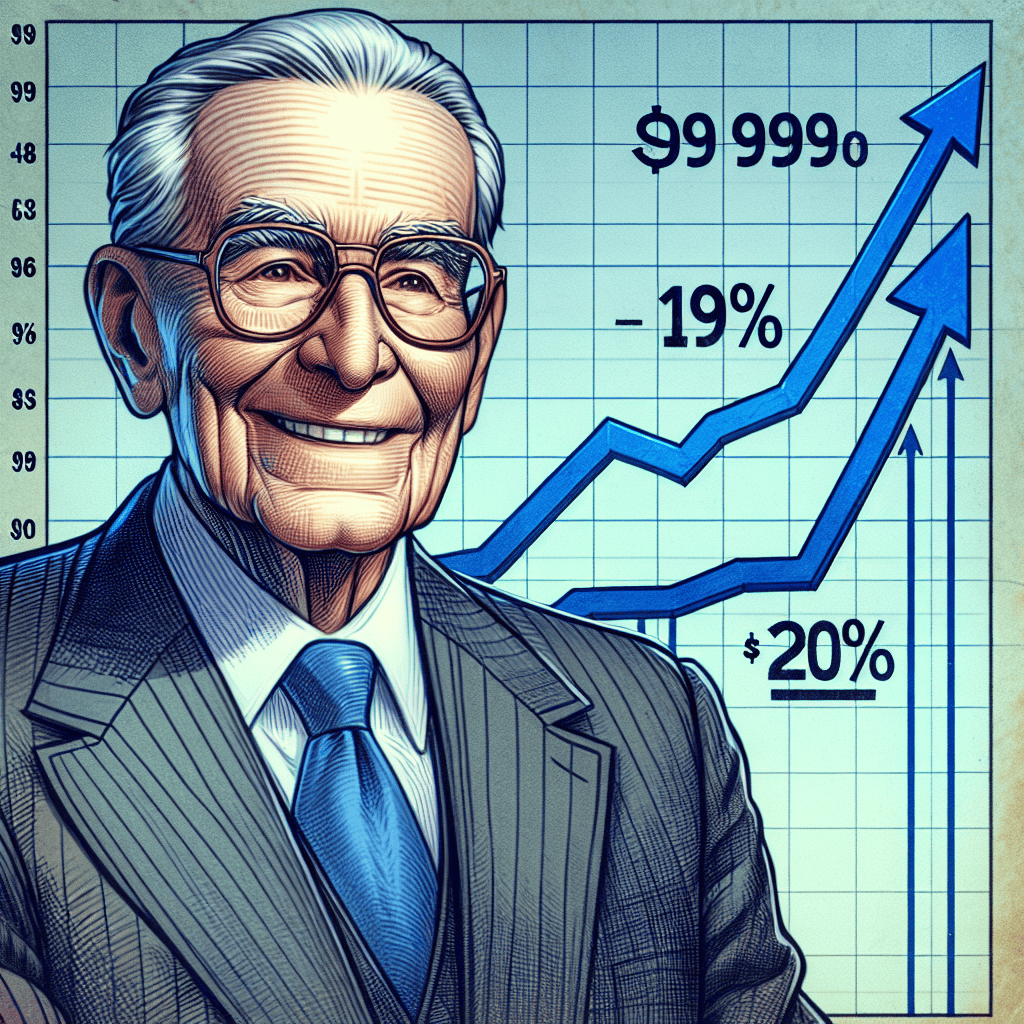“Buffett’s Bold Bet: Analysts Predict Double-Digit Gains in Key Stocks”
Introduction
Warren Buffett, the legendary investor and CEO of Berkshire Hathaway, has made headlines with a substantial $99 billion investment, capturing the attention of market analysts and investors worldwide. This strategic move focuses on two key stocks that are projected to deliver impressive returns, with analysts forecasting gains of 19% and 20%, respectively. Buffett’s investment decisions are closely watched, given his track record of identifying undervalued opportunities and generating significant returns. The anticipation surrounding these stocks highlights the potential for substantial growth and underscores Buffett’s continued influence in the financial markets.
Understanding Warren Buffett’s Investment Strategy: Key Insights from His $99 Billion Move
Warren Buffett, the legendary investor and chairman of Berkshire Hathaway, has long been a figure of fascination in the financial world. His investment strategies are scrutinized by analysts and investors alike, as they seek to understand the principles that guide his decisions. Recently, Buffett made headlines with a substantial $99 billion investment, focusing on two key stocks that analysts predict could yield impressive gains of 19% and 20%. This move not only underscores Buffett’s enduring influence in the market but also offers valuable insights into his investment philosophy.
To comprehend the rationale behind Buffett’s latest investment, it is essential to delve into the core tenets of his strategy. Buffett is renowned for his value investing approach, which involves identifying undervalued companies with strong fundamentals and long-term growth potential. He often emphasizes the importance of investing in businesses with a durable competitive advantage, or what he refers to as an “economic moat.” This concept is crucial in understanding why Buffett might choose to allocate such a significant sum to these particular stocks.
Moreover, Buffett’s investment decisions are typically characterized by a long-term perspective. He famously advises investors to buy stocks with the intention of holding them indefinitely, a principle that reflects his belief in the power of compounding returns over time. This long-term outlook is particularly relevant in the context of his recent $99 billion investment, as it suggests confidence in the sustained growth prospects of the chosen companies.
In addition to these foundational principles, Buffett’s investment strategy is also informed by a rigorous analysis of financial metrics. He places great emphasis on a company’s intrinsic value, which he calculates by assessing factors such as earnings, cash flow, and return on equity. By focusing on intrinsic value, Buffett aims to ensure that he is purchasing stocks at a price that is below their true worth, thereby maximizing potential returns.
The two stocks that have captured Buffett’s attention in this latest investment are believed to align closely with these strategic criteria. Analysts have forecasted gains of 19% and 20% for these stocks, indicating a strong belief in their future performance. This optimistic outlook is likely based on a combination of robust financial health, competitive positioning, and favorable market conditions, all of which are key considerations in Buffett’s investment process.
Furthermore, Buffett’s decision to invest such a substantial amount in these stocks may also reflect broader economic trends and market dynamics. As a seasoned investor, Buffett is adept at identifying opportunities that arise from shifts in the economic landscape. His ability to anticipate and respond to these changes has been a hallmark of his success over the decades.
In conclusion, Warren Buffett’s $99 billion investment serves as a testament to his enduring investment acumen and strategic foresight. By adhering to his core principles of value investing, long-term perspective, and rigorous financial analysis, Buffett continues to make impactful decisions that resonate throughout the financial world. As analysts predict significant gains for the two key stocks in his latest portfolio move, investors and market observers alike are reminded of the timeless wisdom that underpins Buffett’s approach to investing. Through careful consideration of intrinsic value and economic moats, Buffett’s strategy offers a blueprint for navigating the complexities of the market with confidence and clarity.
Analyzing the 19% and 20% Forecasted Gains: What Makes These Stocks Stand Out?
Warren Buffett, the legendary investor and CEO of Berkshire Hathaway, has long been a beacon of wisdom in the financial world. His investment decisions are closely scrutinized by analysts and investors alike, as they often signal broader market trends and opportunities. Recently, Buffett’s $99 billion investment portfolio has drawn significant attention, particularly due to the forecasted gains of 19% and 20% in two key stocks. Understanding what makes these stocks stand out requires a closer examination of their underlying fundamentals, market positioning, and the strategic rationale behind Buffett’s investment choices.
To begin with, the first stock projected to achieve a 19% gain is characterized by its robust financial health and consistent performance. This company has demonstrated a strong track record of revenue growth, driven by its innovative product offerings and strategic market expansion. Analysts have noted that its competitive advantage lies in its ability to adapt to changing market dynamics, leveraging technology to enhance operational efficiency and customer engagement. Furthermore, the company’s management team has been lauded for its prudent capital allocation strategies, which have resulted in sustainable profit margins and a solid return on equity. These factors collectively contribute to the stock’s attractiveness, making it a compelling choice for long-term investors like Buffett.
Transitioning to the second stock, which is anticipated to yield a 20% gain, it is essential to highlight its unique market positioning and growth potential. This company operates in a high-demand industry, benefiting from macroeconomic trends that favor its business model. Its strategic investments in research and development have positioned it as a leader in innovation, allowing it to capture a significant market share. Additionally, the company’s strong brand equity and customer loyalty have fortified its competitive moat, providing a buffer against market volatility. Analysts have also pointed out that the company’s expansion into emerging markets presents a lucrative growth opportunity, further enhancing its appeal to investors seeking exposure to global growth trends.
Moreover, both stocks share common attributes that align with Buffett’s investment philosophy, which emphasizes intrinsic value and long-term growth potential. Buffett’s approach often involves identifying companies with strong fundamentals, capable management, and a clear path to sustained profitability. By investing in these stocks, Buffett is not only capitalizing on their immediate growth prospects but also reinforcing his commitment to value investing principles. This strategic alignment underscores the rationale behind the forecasted gains, as these companies are well-positioned to deliver shareholder value over time.
In conclusion, the forecasted gains of 19% and 20% in these two key stocks within Warren Buffett’s $99 billion investment portfolio are underpinned by their strong financial performance, strategic market positioning, and alignment with Buffett’s investment philosophy. As analysts continue to monitor these stocks, their potential to outperform the market remains a focal point of interest for investors seeking to emulate Buffett’s success. By understanding the factors that make these stocks stand out, investors can gain valuable insights into the dynamics of value investing and the strategic considerations that drive long-term wealth creation.
The Impact of Warren Buffett’s Investments on the Stock Market: A Closer Look
Warren Buffett, often hailed as one of the most successful investors of all time, has long been a figure of immense influence in the financial world. His investment decisions are closely watched by analysts and investors alike, as they often signal potential trends and opportunities within the stock market. Recently, Buffett’s investment firm, Berkshire Hathaway, made headlines with a substantial $99 billion investment, focusing on two key stocks that analysts predict could yield significant gains. This move has sparked considerable interest and speculation about the potential impact on the broader market.
To understand the implications of Buffett’s latest investment, it is essential to consider the historical context of his investment strategy. Known for his value investing approach, Buffett typically seeks out companies with strong fundamentals, competitive advantages, and the potential for long-term growth. His investment philosophy emphasizes patience and a deep understanding of the businesses he invests in, often leading to substantial returns over time. Consequently, when Buffett makes a significant investment, it is often perceived as a vote of confidence in the underlying companies and their future prospects.
In this particular instance, analysts have identified two stocks within Buffett’s $99 billion investment that are poised for notable gains. The first stock is projected to achieve a 19% increase, while the second is expected to see a 20% rise. These forecasts are based on a combination of factors, including the companies’ financial health, market position, and growth potential. Moreover, Buffett’s involvement is likely to attract additional investor interest, further driving up the stock prices and contributing to the anticipated gains.
The impact of Buffett’s investments extends beyond the immediate performance of the selected stocks. His decisions often have a ripple effect throughout the market, influencing investor sentiment and potentially altering the trajectory of related industries. For instance, when Buffett invests in a particular sector, it can signal confidence in that industry’s future, prompting other investors to follow suit. This phenomenon, sometimes referred to as the “Buffett effect,” underscores the significant sway he holds over market dynamics.
Furthermore, Buffett’s investment choices can also serve as a barometer for broader economic trends. By analyzing the sectors and companies he targets, investors can glean insights into his views on the economy’s direction and potential areas of growth. This information can be invaluable for those seeking to align their investment strategies with prevailing market conditions.
In addition to the direct financial implications, Buffett’s investments often carry symbolic weight. His reputation for prudent and successful investing means that his endorsement of a company can enhance its credibility and attract positive attention from both investors and the media. This increased visibility can lead to improved market performance and open up new opportunities for the companies involved.
In conclusion, Warren Buffett’s $99 billion investment in two key stocks has captured the attention of analysts and investors, who anticipate significant gains in the near future. Beyond the immediate financial impact, Buffett’s investment decisions have far-reaching effects on market sentiment and can provide valuable insights into broader economic trends. As such, his actions continue to be a focal point for those seeking to navigate the complexities of the stock market and capitalize on emerging opportunities.
Lessons from Warren Buffett: How to Identify High-Growth Stocks

Warren Buffett, often hailed as one of the most successful investors of all time, has consistently demonstrated an uncanny ability to identify high-growth stocks. His recent $99 billion investment, which analysts predict will yield 19% and 20% gains in two key stocks, offers valuable insights into his investment strategy. Understanding the principles that guide Buffett’s decisions can provide investors with a framework for identifying high-growth stocks in their own portfolios.
To begin with, Buffett’s investment philosophy is deeply rooted in the concept of value investing. This approach involves identifying stocks that are undervalued by the market but have strong fundamentals and growth potential. By focusing on intrinsic value rather than market trends, Buffett is able to pinpoint opportunities that others might overlook. This principle is evident in his recent investments, where he has targeted companies with robust business models and competitive advantages that are likely to drive future growth.
Moreover, Buffett places a strong emphasis on the quality of management. He believes that competent and ethical leadership is crucial for a company’s long-term success. When evaluating potential investments, Buffett looks for management teams with a proven track record of making sound decisions and effectively navigating challenges. This focus on leadership quality ensures that the companies he invests in are well-positioned to capitalize on growth opportunities and adapt to changing market conditions.
In addition to management quality, Buffett also considers a company’s financial health. He meticulously analyzes financial statements to assess factors such as revenue growth, profit margins, and return on equity. By investing in companies with strong financials, Buffett minimizes risk and increases the likelihood of substantial returns. This financial scrutiny is a key component of his strategy, as it allows him to identify companies that are not only undervalued but also financially stable and capable of sustaining growth.
Furthermore, Buffett’s long-term investment horizon is another critical aspect of his approach. Unlike many investors who seek quick profits, Buffett is willing to hold onto stocks for extended periods, allowing time for their intrinsic value to be realized. This patience is particularly important when investing in high-growth stocks, as it provides the necessary time for companies to execute their growth strategies and achieve their full potential. By maintaining a long-term perspective, Buffett is able to weather short-term market fluctuations and capitalize on the compounding effects of growth over time.
Additionally, Buffett’s recent investments highlight the importance of diversification. By spreading his $99 billion investment across multiple sectors and industries, he reduces the risk associated with any single investment. This diversification strategy not only mitigates potential losses but also increases the chances of capturing high-growth opportunities in different areas of the market. For individual investors, adopting a diversified approach can similarly enhance portfolio performance and reduce exposure to market volatility.
In conclusion, Warren Buffett’s investment strategy offers valuable lessons for identifying high-growth stocks. By focusing on intrinsic value, management quality, financial health, and maintaining a long-term perspective, investors can emulate Buffett’s approach and improve their chances of success. Furthermore, diversification remains a crucial element in managing risk and capturing growth opportunities. As analysts forecast significant gains in Buffett’s recent investments, these principles continue to demonstrate their effectiveness in navigating the complexities of the stock market.
The Role of Berkshire Hathaway in Warren Buffett’s Investment Decisions
Warren Buffett, often hailed as one of the most successful investors of all time, has consistently demonstrated an uncanny ability to identify lucrative investment opportunities. His company, Berkshire Hathaway, serves as the primary vehicle through which he executes his investment strategies. With a staggering $99 billion investment portfolio, Berkshire Hathaway’s decisions are closely scrutinized by analysts and investors alike. Recently, two key stocks within this portfolio have garnered significant attention, with analysts forecasting impressive gains of 19% and 20%, respectively. Understanding the role of Berkshire Hathaway in these investment decisions provides valuable insight into Buffett’s approach and the potential future performance of these stocks.
Berkshire Hathaway operates as a conglomerate, owning a diverse range of businesses and holding substantial equity positions in numerous publicly traded companies. This structure allows Buffett to leverage the company’s vast resources and expertise to make informed investment choices. The conglomerate’s decentralized management style empowers subsidiary managers to operate independently, fostering an environment where innovative ideas can flourish. This autonomy, combined with Buffett’s strategic oversight, creates a dynamic framework for identifying and capitalizing on promising investment opportunities.
In the context of the two key stocks poised for significant gains, Berkshire Hathaway’s role is multifaceted. Firstly, the company’s extensive research capabilities enable it to conduct thorough due diligence on potential investments. This rigorous analysis involves evaluating a company’s financial health, competitive position, and growth prospects. By leveraging its vast network of industry experts and analysts, Berkshire Hathaway can make well-informed decisions that align with its long-term investment philosophy.
Moreover, Berkshire Hathaway’s substantial financial resources provide it with the flexibility to take sizable positions in companies it deems promising. This ability to invest significant capital allows the conglomerate to influence the strategic direction of these companies, often securing board seats or engaging in active dialogue with management. Such involvement can drive operational improvements and strategic initiatives that enhance shareholder value, ultimately contributing to the anticipated gains in these stocks.
Additionally, Berkshire Hathaway’s reputation as a patient and long-term investor plays a crucial role in its investment decisions. Buffett’s philosophy of buying and holding quality companies for the long haul aligns with the conglomerate’s approach to these two stocks. By focusing on businesses with strong fundamentals and sustainable competitive advantages, Berkshire Hathaway positions itself to benefit from compounding returns over time. This patient approach not only mitigates short-term market volatility but also allows the company to capitalize on the intrinsic value of its investments.
Furthermore, the anticipated gains in these two stocks reflect broader market trends and economic conditions. Analysts’ forecasts are often influenced by factors such as industry growth, technological advancements, and macroeconomic indicators. Berkshire Hathaway’s ability to navigate these complex dynamics is a testament to its strategic acumen and adaptability. By staying attuned to evolving market conditions, the conglomerate can adjust its investment strategies to maximize returns while minimizing risk.
In conclusion, Berkshire Hathaway’s role in Warren Buffett’s investment decisions is instrumental in driving the anticipated gains in these two key stocks. Through its rigorous research, substantial financial resources, and patient investment philosophy, the conglomerate is well-positioned to capitalize on promising opportunities. As analysts forecast significant gains, the strategic decisions made by Berkshire Hathaway will undoubtedly continue to shape the investment landscape and reinforce Buffett’s legacy as a masterful investor.
Comparing Warren Buffett’s Recent Investments with His Historical Portfolio
Warren Buffett, the legendary investor and chairman of Berkshire Hathaway, has long been a figure of fascination in the financial world. His investment strategies, often characterized by a focus on value and long-term growth, have consistently yielded impressive returns. Recently, Buffett’s $99 billion investment has drawn significant attention, particularly due to analysts forecasting substantial gains in two key stocks within this portfolio. To understand the implications of these predictions, it is essential to compare Buffett’s recent investments with his historical portfolio, examining how his strategies have evolved over time.
Historically, Buffett has been known for his preference for companies with strong fundamentals, competitive advantages, and capable management teams. His investments in iconic brands such as Coca-Cola, American Express, and Procter & Gamble exemplify this approach. These companies, with their established market positions and consistent earnings, align with Buffett’s philosophy of buying quality businesses at reasonable prices and holding them for the long term. This strategy has not only provided stability to Berkshire Hathaway’s portfolio but has also delivered substantial returns over the decades.
In contrast, Buffett’s recent investments reflect a nuanced shift in strategy, likely influenced by the changing dynamics of the global economy and financial markets. Among the $99 billion investment, two stocks have emerged as particularly noteworthy due to analysts’ forecasts of 19% and 20% gains. These projections suggest that Buffett is not only maintaining his focus on value but is also adapting to new opportunities that promise significant growth potential.
One of these key stocks is in the technology sector, a domain that Buffett historically approached with caution. However, his investment in Apple several years ago marked a turning point, demonstrating his willingness to embrace technology companies that exhibit strong brand loyalty and robust financial performance. The current investment in a tech company with a forecasted 19% gain indicates that Buffett continues to recognize the transformative power of technology and its potential to drive future growth.
The second stock, with an anticipated 20% gain, is in the healthcare sector. This aligns with Buffett’s historical interest in industries that provide essential services and have resilient demand. Healthcare, with its demographic tailwinds and ongoing innovation, presents a compelling case for long-term investment. By allocating capital to this sector, Buffett is likely capitalizing on the growing need for healthcare solutions and the potential for substantial returns as the industry evolves.
While these recent investments highlight a degree of strategic adaptation, they remain consistent with Buffett’s overarching investment principles. His focus on companies with strong economic moats, capable management, and the potential for sustainable growth continues to guide his decision-making process. Moreover, the significant capital allocation to these stocks underscores Buffett’s confidence in their ability to deliver value over time.
In conclusion, Warren Buffett’s $99 billion investment, with analysts forecasting notable gains in two key stocks, reflects both continuity and evolution in his investment strategy. By comparing these recent investments with his historical portfolio, it becomes evident that while Buffett remains committed to his core principles, he is also responsive to emerging opportunities in sectors poised for growth. This balance of tradition and innovation is likely to sustain Berkshire Hathaway’s success in the years to come, reinforcing Buffett’s legacy as one of the most astute investors of our time.
The Future of Warren Buffett’s Investment Strategy: What Analysts Are Predicting
Warren Buffett, the legendary investor and chairman of Berkshire Hathaway, has long been a figure of fascination in the financial world. His investment strategies, often characterized by a long-term perspective and a focus on intrinsic value, have consistently yielded impressive returns. Recently, Buffett’s $99 billion investment has captured the attention of analysts, who are forecasting significant gains in two key stocks. These predictions, suggesting potential increases of 19% and 20%, underscore the continued relevance and impact of Buffett’s investment philosophy.
To understand the implications of these forecasts, it is essential to delve into the factors driving these anticipated gains. Analysts have identified several elements that contribute to the optimistic outlook for these stocks. First and foremost, the companies in question are positioned in sectors that are poised for growth. This strategic positioning aligns with Buffett’s historical preference for investing in industries with strong fundamentals and promising futures. By selecting companies that are not only financially sound but also situated in expanding markets, Buffett is effectively leveraging macroeconomic trends to bolster his investment portfolio.
Moreover, the management teams of these companies play a crucial role in the anticipated success. Buffett has always emphasized the importance of competent and visionary leadership, and these firms are no exception. The executives at the helm are not only adept at navigating current market challenges but are also proactive in capitalizing on emerging opportunities. This dynamic leadership is expected to drive innovation and operational efficiency, further enhancing the companies’ growth prospects.
In addition to sectoral growth and strong management, the financial health of these companies cannot be overlooked. Both firms boast robust balance sheets, characterized by low debt levels and healthy cash flows. This financial stability provides a solid foundation for sustainable growth and allows the companies to invest in strategic initiatives without overextending themselves. For Buffett, whose investment strategy often involves holding stocks for extended periods, such financial resilience is a critical factor in ensuring long-term value creation.
Furthermore, the broader economic environment is conducive to the success of these investments. Despite global uncertainties, certain economic indicators suggest a favorable climate for growth. Low interest rates, for instance, have made borrowing more affordable, enabling companies to finance expansion projects at a lower cost. Additionally, consumer confidence remains relatively strong, supporting demand for goods and services. These macroeconomic conditions create a supportive backdrop for the companies in Buffett’s portfolio to thrive.
While the forecasts of 19% and 20% gains are certainly promising, it is important to approach them with a degree of caution. The stock market is inherently unpredictable, and numerous variables can influence outcomes. However, the combination of strategic sector positioning, strong management, financial health, and a supportive economic environment provides a compelling case for optimism.
In conclusion, Warren Buffett’s $99 billion investment continues to exemplify his astute approach to investing. The anticipated gains in these two key stocks reflect not only the strength of the companies themselves but also the enduring wisdom of Buffett’s investment philosophy. As analysts project these significant increases, the financial world watches with keen interest, eager to see how these predictions unfold. Ultimately, Buffett’s strategy serves as a reminder of the power of thoughtful, long-term investing in navigating the complexities of the modern market.
Q&A
1. **What is Warren Buffett’s $99 billion investment focused on?**
Warren Buffett’s $99 billion investment is focused on Berkshire Hathaway’s significant holdings in various companies, with particular attention to two key stocks expected to yield substantial gains.
2. **Which two key stocks are analysts forecasting gains for?**
Analysts are forecasting gains for Apple Inc. and Bank of America Corp., two major holdings in Berkshire Hathaway’s portfolio.
3. **What are the expected gains for these two stocks?**
Analysts are predicting a 19% gain for Apple Inc. and a 20% gain for Bank of America Corp.
4. **Why is Apple Inc. a significant investment for Warren Buffett?**
Apple Inc. is a significant investment for Warren Buffett due to its strong brand, consistent revenue growth, and substantial cash flow, making it a cornerstone of Berkshire Hathaway’s portfolio.
5. **What makes Bank of America Corp. an attractive investment?**
Bank of America Corp. is considered an attractive investment because of its robust financial position, potential for interest rate-driven revenue growth, and strategic initiatives to enhance profitability.
6. **How does Warren Buffett’s investment strategy influence these forecasts?**
Warren Buffett’s investment strategy, which focuses on value investing, long-term growth, and investing in companies with strong fundamentals, influences these forecasts by identifying stocks with potential for significant appreciation.
7. **What role do analysts play in these investment forecasts?**
Analysts play a crucial role in these investment forecasts by conducting in-depth research, evaluating market trends, and assessing the financial health and growth prospects of the companies involved.
Conclusion
Warren Buffett’s $99 billion investment, with analysts forecasting 19% and 20% gains in two key stocks, underscores his strategic acumen in identifying undervalued opportunities with significant growth potential. This move not only reflects Buffett’s confidence in the long-term prospects of these companies but also highlights his continued influence in the investment world. The anticipated gains suggest a positive outlook for these stocks, reinforcing Buffett’s reputation for making astute investment decisions that align with his value investing philosophy.





